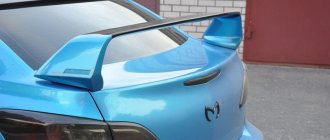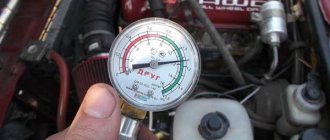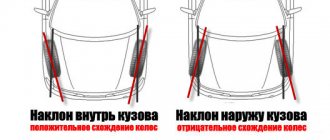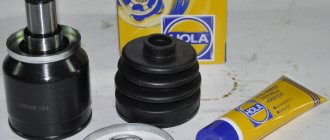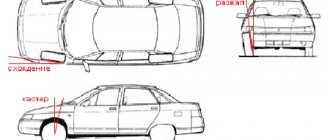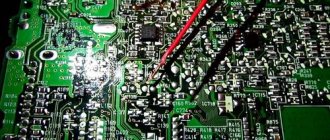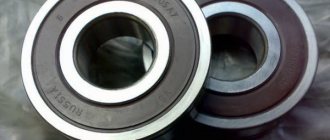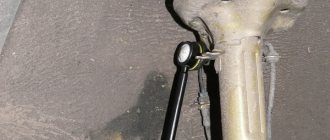To reliably protect the car body, they use the so-called “liquid glass” or otherwise “nanoceramics”. This coating provides mirror shine and additional car color fastness. We will conduct review of 10 popular products “liquid glass” for car polishing and reveal rating best brands in different price segments.
What is liquid glass
Most often this is an aqueous alkaline solution of potassium or sodium. It has excellent adhesive properties and does not allow water to pass through.
A different chemical composition is used to protect the car body. This is silicon dioxide from which synthetic glass can be made.
This type of car treatment was invented in Japan in 2008. The popularity of this coating is explained by the fact that, unlike other compositions, it lasts quite a long time.
Actual service life
Manufacturers promise on their websites, in instructions and at exhibitions that if the application technology and operating rules are followed, its protective properties will last up to 24 months. Perhaps this is so, but...
We live in Moscow, where roads are repaired more often than they are washed. Where the rains nail all the emissions from local thermal power plants and factories to the ground. Where there is snow in winter, which means winter brushes for sweeping away snow. Where those who work at car washes are the ones who saw a four-wheeled car for the first time yesterday (no offense). Where dirt from dividing strips and lawns is drained onto the road. Where a winter reagent corrodes leather boots in a couple of days...
Let's be realistic. If all rules and technologies are followed during application, it will last up to 4 months. If you exclude “animal washers”, winter brushes and aggressive chemicals (shampoos, waxes, isopropyl anti-freeze...) you can actually extend the service life to 8 months.
BMW of a regular customer of the Brilliant Detail detailing center on corrective polishing and protection with one layer of liquid glass
Types of liquid glass
At the moment there are three types of liquid glass. It is on their basis that liquid glass for cars is made, used as a polish.
Potassium - based on potassium, has a significant difference due to its friability and the property of increased hygroscopicity.
Sodium - based on sodium, has excellent fire retardant properties.
Lithium is the rarest liquid glass today, produced in small quantities, used as a temperature regulator for coating.
[su_divider top=»no» style=»double» divider_color=»#238516" size=»6" margin=»5"]
Current Auto News
[su_cu[su_custom_gallery source="taxonomy: post_tag/1063,1098,1129" limit="3" link="post" target="blank" width="190" height="190" title="always"]p> [su_divider to[su_divider top=»no» style=»double» divider_color=»#238516" size=»6" margin=»5"] three types of liquid glass can be included in one group of mono-alkaline compositions. In addition, there are also combined and complex.In Russia, the majority of liquid glass production is occupied by the production of sodium compounds.
Manufacturers and cost
Liquid glass for cars is produced by many manufacturers.
Of course, such a promising market as liquid glass for car bodies is attractive to a large number of manufacturers. Among them are representatives of different countries and price categories: V-MAFA (China), KillAqua (Russia), GYEON and CQuartz (South Korea), Nanoskin (USA) and Willson (Japan). Also, when listing brands of polishes and liquid glass for cars, it is certainly worth remembering Everglass - a professional-grade ceramic coating, unfortunately, available for application only in auto centers. When choosing liquid glass for a car, which one is better is a controversial issue. Here you should take into account the ratio of cost, duration of action, resistance to detergents, ease of application, layer strength and water-repellent properties. So, each brand has its own characteristics. For example, liquid glass for cars Willson glass guard , which is based on silicon dioxide, when applied to the body, can provide protection for at least a year, with an average price of $60. By the way, this line has separate products for dark and light cars, which allows you to restore the brightness of the original body color as much as possible.
Article on the topic: The principle of operation of glow plugs, service life, how to check their operation
The Korean brand CQuartz also uses silicon dioxide and can withstand up to fifty washes. The price range starts from $50, but the main advantage of this product is the adaptation of the product to our climatic conditions. Its sister brand, GYEON, lasts for eighty washes. At the same time, when assessing the antistatic properties of this liquid glass for cars, reviews from owners indicate that the intervals between washes are significantly increased. In turn, the domestic KillAqua offers protection from six months to three years, with an average cost of $80. But there are very controversial reviews regarding this brand. So, for some, the price for real quality is too high, while others do not notice a positive effect at all.
Coating a car with liquid glass: pros and cons
Like all products, liquid glass polish has pros and cons. We will look at the advantages and disadvantages of such coverage, and it’s up to you to make the final choice.
Among the advantages are:
- resistant to moisture, does not become dirty during rain;
- withstands minor scratches;
- application does not require much effort;
- no additional protective coating required;
- the color of the car does not fade and retains its original appearance;
- availability of a large selection of different manufacturers;
- the work can be done even in a car wash;
- takes relatively little time to apply.
But there are also disadvantages:
- there are times when you should use a grinding machine, and this is an additional waste;
- re-application is necessary after 6-8 major washes;
- applying polish in sub-zero temperatures will not work; Although applying the product takes little time, it dries much longer.
Briefly: what is it and how to treat a car
Processing before and after
According to the advertisement and the inscriptions on the product jars themselves, liquid glass is a means for treating a car by polishing. The main useful qualities, according to manufacturers, are protection against scratches and resistance to body contamination. The roots of this car treatment come from Japan, where the coating has taken root a long time ago. In Russia, liquid glass has been used, although not for a long time, but already professionally. There are many car wash centers open where you can listen to reviews and opinions of both sellers and customers.
The procedure for processing a car is simple, but deserves a separate description, which you can read in our next articles. Let's discuss the main rules. First, you need to read the instructions carefully. There are many manufacturers and different variations of liquid glass, so it is important to know the technology and procedure for coating a car so as not to cause harm. Secondly, the car being processed must be perfectly clean. Wash as much as possible using car shampoos. Believe me, there is no need to skimp on washing. Thirdly, if you polish it yourself, find a clean garage, but it’s better to do it in a paint booth. If you order liquid glass treatment for your car from a company, then follow the sterility requirements. These are all the rules for good work. Here is one way to apply a protective coating in video format:
How much does it cost to cover a car with liquid glass?
With the price of liquid glass at 1000-6000 at a service station, you will have to pay 5000-17000 for one procedure, depending on the class of car. The course is extortionate, however, it is payment for free time. If you have enough of it, go to the store and take a closer look at polishes. The best are considered:
- Wilson Liquid glass covers 60% of the country's cars. It is used in service centers and at home. Packaged in containers of 100 and 500 ml. A small bottle is enough for 2 procedures. Price from 1500–7000. It's easy to calculate how much you save by doing the polishing yourself.
- “Liqui-Moli” Reviews about liquid glass are the most positive. Car owners say that the car changes before their eyes: the sun reflects on the sides of the body, water flows down as if it had fallen on a wax surface. The price of a small bottle is 3000 rubles. We must pay tribute to German quality - a single polish will remain on the car even after several months and will survive up to 50 washes.
- “AQuly” I call this product a polish for the lazy. One polish will provide the car with a protective coating for 5 weeks. The price is similar to Wilson. At the same cost, it is better to give preference to the latter.
The product does not require additional tools, which allows you to save on it. But it should be borne in mind that the surface of the body must be cleaned with special care before applying it. This means that you will need to take into account the cost of these works, which require the purchase of additional materials. In total: covering a car with liquid glass is not a small price...
Questions and answers
Choosing liquid glass is not difficult. It is sold at any car store. But it’s still better to purchase products from trusted manufacturers.
How long does liquid glass last?
This will depend on the manufacturing company. Modern products last up to 3 years, but in Russian conditions, as a rule, they last no more than 12 months.
How much does it cost to cover a car with liquid glass?
The cost of the product is just one of the cost items. Taking into account the manufacturing company, you need to pay $30-350 for packaging. For a small car, 50 ml is most often enough. If a minivan or jeep is processed, then the consumption is 2 times more.
In addition to polish, you will need:
- degreaser for removing greasy film from paintwork (about $4);
- cleaner if there is stubborn dirt (about $16);
- car wash shampoo (approximately $6);
- if the car is old, you need to remove scratches (polishing will cost about $50).
It is clear that sometimes to coat with liquid glass you need to spend much more than paying directly for the composition. If the work is performed by specialists at a car dealership, then expect that their work costs the same as the purchased product.
These compounds are not included in the group of mandatory automotive products that every car owner must use. This is one of many products to care for the appearance of your car. Taking this into account, the car owner must determine for himself whether he needs it or not.
Surface preparation
Step one. Washing and drying the car outside.
If you do it yourself, then you should take into account that neither foam rubber nor a rag are suitable - they hold small hard particles well, which will certainly cover the body of the body with a mesh of tiny scratches. You need a rubber hose and a soft brush with long bristles.
Hose down the entire car and wait a few minutes for the dirt to soak up. In a bucket, prepare a solution of special car shampoo (only this!) and, dipping a brush into it, clean off all the dirt, constantly watering it with a hose.
Important: be sure to wash with shampoo and not hot water. Otherwise, the smallest dirt will remain in the pores and cracks, which will absorb moisture, and then it will penetrate under the paint. The result will be rust.
But first, clean all the drainage holes in the doors, sills, and front fenders so that water does not get into the cavities and cause further corrosion.
And at the end of the wash, remove all droplets of water with a wrung-out clean suede cloth so that small white spots do not appear in their places due to sunlight.
To complete the first stage, wipe the entire washed surface with a dry soft cloth (napkin).
Step two. Degreasing.
Everything that is not dissolved by water is eliminated.
The entire surface of the dried body is degreased with white spirit. It has a pungent odor, so the room must have good ventilation or you must wear a respirator. Be sure to wear rubber gloves. First, white spirit is applied, after some time the dirt is removed with a soft, lint-free cloth.
Be careful - if the contamination is bitumen, then you need to use special bitumen cleaners. Do not use gasoline, kerosene, etc. under any circumstances. - on varnish and paint. Only possible on bare metal surfaces. Remove old polish. At the end, the body is covered with a cleaning solution, and everything is washed off.
How to distinguish a fake. The cost of the original. Where can I buy
The main indicator of the original Silane Guard set is the cost. The stated price by the manufacturer is 5,200 yen. This is about 3060 rubles. Bottle volume – 95 ml. Inexplicable cheapness, suspicious discounts and promotions say one thing - the client is looking at a fake product. The use of chemicals will not bring results and is dangerous for the paint.
True kit includes:
- reagent bottle;
- glove;
- sponge;
- polishing cloth;
- user manual.
The original packaging has the company logo in the upper left corner. The box material is of high quality, without defects.

